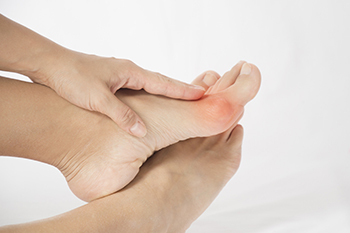Flint Office
1303 S. Linden Rd., Suite D
Flint, MI 48532

Bunions are more than just a bump on the side of your big toe, they can cause chronic discomfort and significantly affect daily life. In addition to the classic symptoms of redness, swelling, and pain at the joint, a bunion may also lead to numbness, tingling, and calluses due to shoe friction. Some people experience balance issues or compensation pain in the knees, hips, or lower back, as they shift their weight to avoid pressure on the bunion. Over time, as the big toe angles sharply toward the other toes, overlapping or joint stiffness may occur. A podiatrist can evaluate the severity of the bunion and offer tailored treatment options, from custom orthotics and footwear recommendations to padding, targeted exercises, and surgical solutions, if necessary. Early intervention can slow progression and relieve discomfort. If you have a painful bunion, it is suggested that you schedule an appointment with a podiatrist for appropriate treatment.
If you are suffering from bunion pain, contact one of our podiatrists of Community Podiatry Group. Our doctors can provide the care you need to keep you pain-free and on your feet.
What Is a Bunion?
Bunions are painful bony bumps that usually develop on the inside of the foot at the joint of the big toe. As the deformity increases over time, it may become painful to walk and wear shoes. Women are more likely to exacerbate existing bunions since they often wear tight, narrow shoes that shift their toes together. Bunion pain can be relieved by wearing wider shoes with enough room for the toes.
Causes
Symptoms
In order to diagnose your bunion, your podiatrist may ask about your medical history, symptoms, and general health. Your doctor might also order an x-ray to take a closer look at your feet. Nonsurgical treatment options include orthotics, padding, icing, changes in footwear, and medication. If nonsurgical treatments don’t alleviate your bunion pain, surgery may be necessary.
If you have any questions, please feel free to contact our office located in Flint, MI . We offer the newest diagnostic and treatment technologies for all your foot care needs.